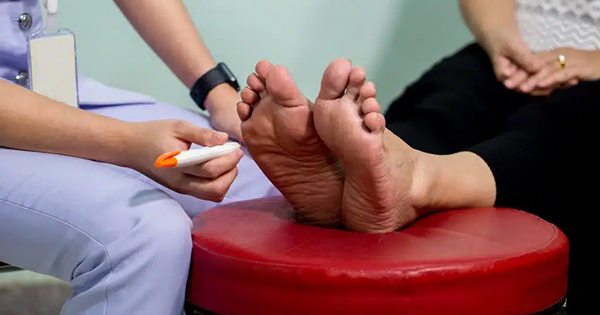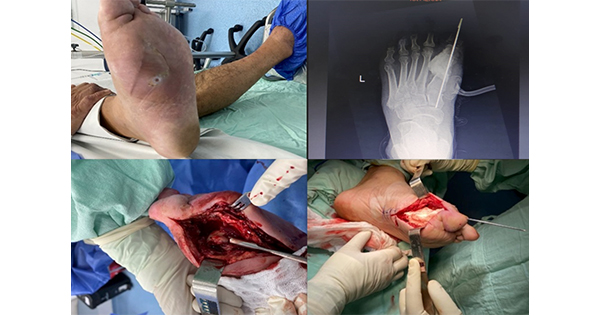Orthoses may be categorised as prescribed functional orthoses, ready-prepared orthoses, or prescribed simple insoles (Figure 1).
- Simple insoles are used to reduce shock attenuation, redistribute pressure, reduce shearing forces and stabilize and support deformities.
- Ready-prepared orthoses are often pre-packaged, with the advantage of inclusion of different orthotic materials for control, support, shock absorbency or re-distribution. They are readily available at low cost, and can be used as a temporary orthosis until a prescription functional orthosis is fabricated.
- Functional orthoses provide mechanical control of the foot, usually require a prescription and are then issued at a later consultation (Tollafield et al, 1997).
The key to this classification is the degree of flexibility and rigidity. However, the words rigid and flexible have no real meaning in this context, as all orthotic materials have a certain degree of flexibility and rigidity. Selection of the appropriate orthotic material and its construction into the correct device ensures that the material will bend a certain amount whenever a load is applied.
The flexibility of any orthotic material is a function not only of its molecular make-up but also of a number of other factors, including hardness, thickness and compression set. Hardness is measured by a durometer: the greater the durometer reading, the more dense and rigid the material. The use of orthotic materials in shock absorption and cushioning is limited.
Thickness of the material also has a marked influence on flexibility. Flexibility is inversely proportional to the cube of the cross-sectional area; thus the flexibility of polypropylene, for example, may be equal to the flexibility of carbon–graphite composite if the polypropylene is thick enough or the carbon–graphite composite is thin enough.
Colagiuri et al (1995) demonstrated that rigid orthotic devices can reduce the thickness of callus by redistributing abnormal plantar pressures. Lemmon et al (1997) reported that an orthosis of given thickness diminishes peak plantar pressure more effectively when tissue thickness is reduced.
Compression set is the residual contraction of the material after it has been compressed for a given time and then allowed to recover for a given time (Rome, 1991). It is caused by damage to the cell matrix after repeated loading and effectively limits the lifetime of the material. Compression set cannot be used alone for assessing orthotic materials, but it is useful when used in combination with other factors such as compression, hardness and density.
Although previous work has suggested that open-cell polyurethane foam and non-cellular viscoelastic polymer suffer from the least compression set over 72 hours’ wear (Edwards and Rome, 1992), cyclic loading and temperature have been shown to affect the efficacy of orthoses. The patient’s weight and build also need to be considered.
Role of orthotic materials
In foot orthotic therapy, the older, more traditional materials, such as cork, leather and board, are now being replaced by newer materials (Table 1). Millions of pounds have been spent on the research, development, and purchase of materials suitable for use in foot orthoses.
In the commercial market, the goal is to construct more comfortable, supportive, and durable orthoses for use by athletes as well as for everyday use. In the diabetic field, the goal is to develop materials that reduce plantar pressure, enhance shock absorbency and control foot movement, thereby protecting patients from life-long disability and improving their quality of life (Sanfilippo et al, 1992).
The properties and uses of materials in orthotic therapy have been determined by manufacturers of orthoses, using subjective evaluation, rather than by clinicians and/or medical personal conducting scientific research (Table 1). In order to prescribe orthoses, the clinician needs not only to understand and evaluate the biomechanics of the foot, especially in relation to the development of plantar ulceration, and identify areas of excessive plantar pressure (Janisse, 1993), but also to possess good background knowledge of the material from which each device is made (Rome, 1990).
The range of materials available for the manufacture and fabrication of orthoses is continually increasing, with simple rubber foams at one end of the spectrum and more complex carbon–composite materials at the other (Table 2). It is estimated that £250 million is spent annually on prefabricated commercial foot products (Kitaoka et al, 1997), and that 6–10 million people require custom-made foot products each year.
Despite the frequency with which orthoses are prescribed and costs often in excess of £200 per pair, limited information is available about their mechanical and clinical efficacy. Typically, the choice of materials for constructing an orthosis has been based on cost and availability (Campbell, 1982). Furthermore, the design of orthoses for diabetics is still largely based on experience and opinion rather than on experimentally confirmed design principles (Ulbrecht et al, 1993).
Foot biomechanics in the diabetic patient
In order to fully understand the role of orthotic materials on the biomechanics of the foot in the diabetic patient, it is necessary to consider the biokinetics of the shoe–foot interface. Bevan (1992) suggested that compensatory or excessive pronation may contribute to the development of plantar ulceration in diabetic patients. Functional foot orthoses have been advocated as a form of mechanical therapy in diabetics with a pronated foot type (Albert and Rinoie, 1994). Consistently high levels of acceleration during walking may also be detrimental to the normal body healing process, and contribute to foot ulceration and avascular necrosis (Kippen, 1989). One way to reduce the effects of dynamic loading on the musculoskeletal system is to provide the foot with external shock absorbers, such as simple insoles made from polyurethane foams or polymers, or a combination of materials.
During locomotion, as body weight transfers from one foot to the other, pressure equal to 60% of body weight is thrust upon the plantar tissues of the foot in 20ms. Elevated plantar pressure is a significant risk factor for foot ulceration (Veves et al, 1992); diabetic patients often have elevated plantar pressures as the result of peripheral neuropathy (Cavanagh and Ulbrecht, 1994). Elevated metatarsal head pressure has also been associated with reduced toe function (Boulton et al, 1987).
Limited joint mobility has been reported to contribute to high plantar pressures, and changes in both the soft tissues and bone of the foot in diabetic patients have the potential to affect plantar pressure, especially in those with a Charcot joint or amputations (Cavanagh and Ulbrecht, 1994).
Rigid foot orthoses have been advocated as a means of reducing the incidence of foot ulceration and preventing secondary infection (Novick et al, 1993).
Lemmon et al (1997) reported that a polyurethane foam orthosis reduced plantar pressure by a maximum of about 30% and was more effective when submetatarsal tissue thickness was reduced. Others have advocated the use of total contact cast treatment as a means of treating neuropathic ulcers and Charcot foot, owing to its ability to redistribute pressure, immobilize, and reduce swelling (Walker et al, 1987; Levine and Myerson, 1995).
The ‘Scotchcast boot’ – a lightly padded boot enclosed by a shell of fibreglass tape – is another technique in which the ankle is not fixed (Burden et al, 1983). However, the problem may re-establish once the ambulation recommences or the cast is no longer worn, unless appropriate footwear and orthotic control are provided. The Scotchcast boot is contraindicated in the presence of severe infection, or ischaemic or neuroischaemic ulceration.
In the younger patient, it may be possible to achieve a degree of improvement in the position and alignment of the lower limb by the use of functional orthoses, whereas in the older patient and those affected bysecondary arthritis, this is less likely (Mooney, 1997). For these patients it is important to accommodate the presenting problem, and redistribute pressure and shear away from the ulcer site (Ullman and Brnick, 1991). In all cases, appropriate footwear, using extra depth or custom-made shoes, is essential and needs to be selected for each patient’s individual needs.
Several studies have advocated the use of viscoelastic polymers in reducing plantar foot pressures (Boulton et al, 1984; Edmonds et al, 1986). However, Cornwall and McPoil (1997) have suggested that viscoelastic polymers may be inappropriate where a reduction in pressure acting through the rearfoot is indicated. They postulated that the material’s ability to resist force is time dependent. As the rate of force loading increases, so too does the stiffness of the material. During the initial contact of walking, these polymers appear to react more stiffly to high impact peaks, demonstrating a maximum pressure similar to that exerted in barefoot walking.
Brodsky et al (1988) noted similar effects when reporting that viscoelastic materials were quite rigid and the least effective in reducing forces acting over a simulated bony prominence. In the forefoot region, although the magnitude of vertical forces is usually higher than in the rearfoot, the vertical force is applied more slowly as body weight is advanced over the supporting leg.
Future recommendations
An accommodative device made of a soft, mouldable material such as low-density polyethylene foam (Plastazote) has been shown to best reduce damaging stresses (Leber and Evanski, 1986). However, when this material is used as a single density orthosis, evidence of permanent breakdown at a less desirable rate is apparent (Rome, 1990). Furthermore, a device that is too rigid or provides too much mechanical control can reduce a patient’s ability to tolerate the device, or even create additional ulceration. The use of various materials in an incremental approach to orthotic rigidity may solve the problem.
Theoretically, one could expect optimal results with a maximally controlling orthosis. But anecdotal evidence has shown this is not always the case. Device intolerance can stem from compensations arising from longstanding biomechanical problems. A significant number of orthotic treatment failures due to patient intolerance result from improper diagnosis, measurement, casting, prescription, and/or fabrication. Nonetheless, some level of mechanical control may be necessary to restore a semblance of reasonable foot function.
Empirical data suggest that combining materials of different densities and molecular structure will not only reduce the rate of material breakdown, but also synergistically enhance the properties of each material. By combining various materials judiciously, an orthotic device may be ‘titrated’ to a patient’s particular needs. For example, a total contact insole combining both accommodative and functional properties was proposed by Janisse (1993). The device consisted of a top layer of polyurethane foam, a middle layer of sponge rubber or a urethane polymer for shock absorption, and a bottom layer of either cork or a denser polyethylene foam for control. While the use of dual density may be considered more cost-effective, the inclusion of a third intermediate-density material would seem unnecessary.
Unfortunately, there is very little scientific information available to guide physicians, podiatrists, orthotists and other specialised diabetes health professionals, such as nurses, in the selection of appropriate materials and type of orthosis. Likewise, there are no data concerning the durability of these materials or information to suggest when foot orthoses should be replaced. A patient with an ischaemic and/or neuropathic ulceration, with or without cellulitis, infection or a neuropathy needs to be considered on an individual basis. Orthotic management, whether it uses a simple insole or a manufactured prescription functional orthosis, is carried out with the aim of achieving one or more objectives of orthotic therapy (Table 3).
However, not all diabetics will require an orthosis. Indeed, there are many contra-indications to orthotic therapy, e.g. patient intolerance or when surgery is advocated. Clinical trials on combinations of materials, to determine cost-effectiveness, patient tolerance, and biomechanical properties are needed.
Conclusion
Orthoses with multiple layers, variable densities, and moulded contours are commonly used for the conservative management of the diabetic foot. A thorough understanding of the entire spectrum of orthotic materials will enable the practitioner to combine orthotic materials to the patient’s best advantage. Clinicians should not assume that the more popular materials or material combinations are the most effective in reducing stresses on the foot. Further investigation is necessary to determine whether these multi-density material combinations reduce damaging plantar pressure and shear while remaining durable for long-term use.
Furthermore, the concept of modifying orthoses via incremental rigidity may help the clinician more precisely address the patient’s needs. Rather than working on the assumption that more functional control is always the way forward, clinicians should instead consider each patient’s requirements individually and vary the rigidity of the orthotic devices accordingly. This approach may improve patient tolerance and avoid creating potentially catastrophic and life-threatening problems.




